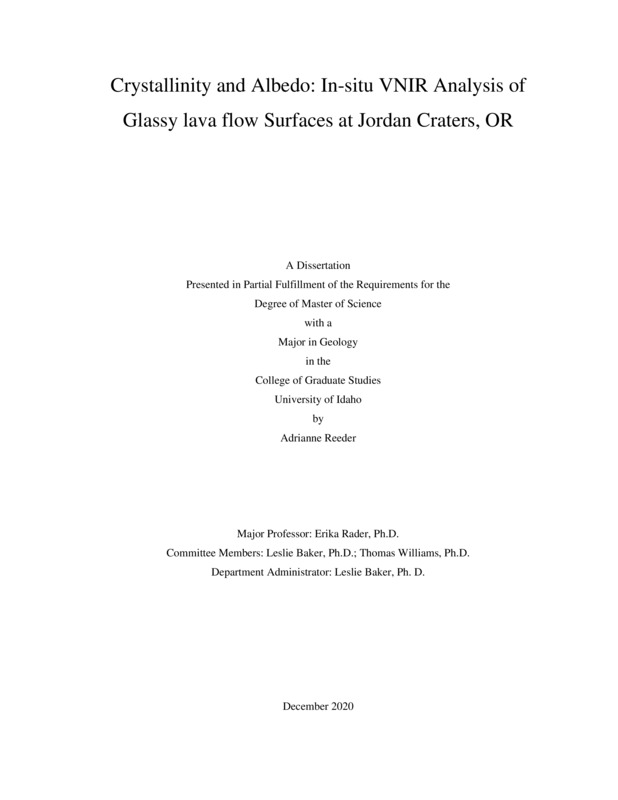Crystallinity and Albedo: In-situ VNIR Analysis of Glassy lava flow Surfaces at Jordan Craters, OR
Reeder, Adrianne. (2020-08). Crystallinity and Albedo: In-situ VNIR Analysis of Glassy lava flow Surfaces at Jordan Craters, OR. Theses and Dissertations Collection, University of Idaho Library Digital Collections. https://www.lib.uidaho.edu/digital/etd/items/reeder_idaho_0089n_11933.html
- Title:
- Crystallinity and Albedo: In-situ VNIR Analysis of Glassy lava flow Surfaces at Jordan Craters, OR
- Author:
- Reeder, Adrianne
- ORCID:
- 0000-0002-1979-714X
- Date:
- 2020-08
- Keywords:
- Albedo Basalt VNIR Volcanology
- Program:
- Geology
- Subject Category:
- Geology
- Abstract:
-
We present an in-situ analysis of the albedo of Visible Near Infrared (VNIR) and the petrologic texture of the surface of a glassy lava flow at Jordan Craters, OR. 10 of our collected samples, from the surface and vent of our flow, had very low reflectance in the VNIR range 0.02 – 0.04 and textures of mostly glass and phenocrysts of olivine and plagioclase. These dark samples were rapidly quenched morphologies, like spatter and scoria. Samples that had brighter VNIR (33% of samples) and had defined absorption bands at 500nm, 1500nm, 1900nm, and 2100nm also had devitrification, alteration, or higher crystal content, and were collected along the margins of the flow. Alteration was identified through the presence of specific absorption bands, e.g. 1900nm, while devitrification and higher crystal content were differentiated based on the depth of the absorption bands, with higher crystal content having the more well-defined absorption bands. We attribute these variations, alteration and devitrification, to the presence of water both during emplacement and post-cooling. A ~0.03 change in albedo that correlated to a range of 28% to 81% glass content across the flow was most clear from the in-situ measurements but was also broadly detectable from satellite ASTER data. Our findings indicate that VNIR can be used to identify variations in petrologic texture across glassy basaltic lava flows. In settings where in-situ study is not possible, such as on Mars, satellite data may give insight to where quenched basalts occur. This has implications for estimating the distribution of ancient water or ice on Mars and will allow for the better identification of locations for in-situ study by rovers for looking for evidence of ancient life.
- Description:
- masters, M.S., Geology -- University of Idaho - College of Graduate Studies, 2020-08
- Major Professor:
- Rader, Erika
- Committee:
- Baker, Leslie; Williams, Thomas
- Defense Date:
- 2020-08
- Identifier:
- Reeder_idaho_0089N_11933
- Type:
- Text
- Format Original:
- Format:
- application/pdf
- Rights:
- In Copyright - Educational Use Permitted. For more information, please contact University of Idaho Library Special Collections and Archives Department at libspec@uidaho.edu.
- Standardized Rights:
- http://rightsstatements.org/vocab/InC-EDU/1.0/

